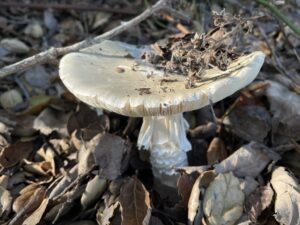It may be safely said that there are two kinds of people: those who notice mushrooms and those who don’t. Likewise, there are two kinds of noticers: the appreciative and the appalled. Retired East Bay Regional Park District naturalist Ron Russo sums up years of visitor reaction: “For the most part there’s a general disdain. They have heard so many stories about poisonous mushrooms.” A few find their very existence offensive: Charles Darwin’s daughter Etty patrolled the grounds of her estate for suggestively shaped stinkhorns, burning them in her fireplace before her housemaids got a glimpse of them.
Such reactions are unfortunate. There’s much to value in a mushroom, even the homely “dead man’s foot.” Culinary uses aside, fungi have their own aesthetic appeal: the spectral elegance of the amanitas, the vivid reds and greens of the waxy caps. “Mushrooms can be every bit as beautiful as birds, butterflies, shells, and flowers,” wrote David Arora in his classic Mushrooms Demystified. Beyond that, mushroom-forming fungi are part of intricate ecological networks incorporating plants, animals, and other fungi. Indeed, without them, our ecosystems as we know them would not exist.
A caveat up front: Collecting mushrooms (or plants or animals, for that matter) is not allowed in many public parks, including in the East Bay Regional Parks. You may have philosophical differences with that policy, but park employees, including the park police, don’t want to argue philosophy. Just look, photograph, or sketch.
With their mosaic of habitats, the East Bay Regional Parks have a generous endowment of these bizarre organisms. “Bizarre” is not too strong a word, and I’m not even talking about the folklore: the dancing fairies, the butter-churning witches, the belief that mushrooms were generated by thunder (or by shooting stars). It may or may not present a problem for vegans, but mushrooms aren’t plants. They’re their own kingdom, coequal to plants and animals–and in some ways more like animals than plants. The cell walls of fungi contain chitin, the same material that makes up the exoskeleton of a grasshopper or the shell of a lobster. But unlike plants and animals, which typically grow by adding cells, most mushrooms just expand by filling a fixed number of preexisting cells with water.
The part of a fungus that we generally see is the fruiting body. Like a strawberry or an apple, it’s a device for sending new individuals out into the world, whether as fungus spores or the seeds of plants. Most fruiting bodies are ephemeral, decomposing after they’ve released their spores. Shaggy mane mushrooms (Coprinus comatus) digest themselves as they release their spores. However, some species, notably the shelf or bracket fungi, have woody perennial fruiting bodies.
The rest of the fungus is below ground or under the bark of a tree: a tangle of filaments called hyphae that make up the mycelium. Sometimes, as with truffles, the fruiting body is also concealed in the soil. Individual mycelial masses can be enormous. The current record-holder, an Armillaria ostoyae in Oregon, covers 2,400 acres (nine square kilometers) and may be 8,500 years old. Since all its parts are connected and genetically identical, it’s regarded as a single organism.
Mushroom growth may be simple, but fungal reproduction can be mind-bogglingly complex. Although some fungi are made up of only two sexes as plants and animals are, in other species, two distinct sets of genes determine gender, which can result in dozens or hundreds of “mating types” of mycelial filaments, each of which is compatible with another group of types. To us, they all look alike. In the ubiquitous splitgill (Schizophyllum commune), one set of genes has 350 known variations, the other 60, for a total of 21,000 possible combinations.

There’s a seasonal rhythm to mushroom growth. Debbie Viess, cofounder of the Bay Area Mycological Society, has watched the cycle in Huckleberry Regional Preserve for years: “After the fall rains begin, the first to come up are the boletes and amanitas,” she says. “It takes a couple of weeks. The mycelia are there, underground, all the time. They wait for the water source before they set their primordia, the incipient mushrooms, which are like those ‘magic sponges.’ They’re perfectly formed and just expand.” After those precursors comes a bloom of chanterelles, waxy caps, russulas, redwood rooters, and myriad others. Viess says spring rains are less productive in the East Bay hills, although the deadly destroying angel (Amanita ocreata) can have vernal flushes. But there are no hard and fast rules: “Mushrooms aren’t necessarily limited by season. It’s a crapshoot. They don’t tell me what they’re going to do.” Mushroomers, she advises, should “go out with very little expectation and be open to anything.” Longtime local fungophile John Sutake agrees: “Mushrooms tend to respond to both the calendar and the moisture level. After a dry winter, you can find a lot of ‘fall’ mushrooms in spring if the moisture is appropriate.”
As a rule of thumb, some mushroom species prefer certain habitats and plant communities. Chanterelles, amanitas, russulas, and boletes occur under coast live oaks and also with other oak species in the wilder parks farther east. Oyster mushrooms (Pleurotus ostreatus) can be found on streamside alders and big-leaf maples. In Redwood Regional Park, the redwood rooter (Caulorhiza umbonata), named for its long “taproot” (which is not really a root), is associated with the giant conifers, as are some agarics and waxy caps. Even planted, nonnative Monterey pines and Monterey cypresses have their fungal sidekicks: slippery jacks (Suillus) with pines, blewits (Clitocybe nuda) with cypresses. Russo says there’s more variety on the east side of the Berkeley-Oakland hills than on the west. Those are general patterns; there are always surprises.
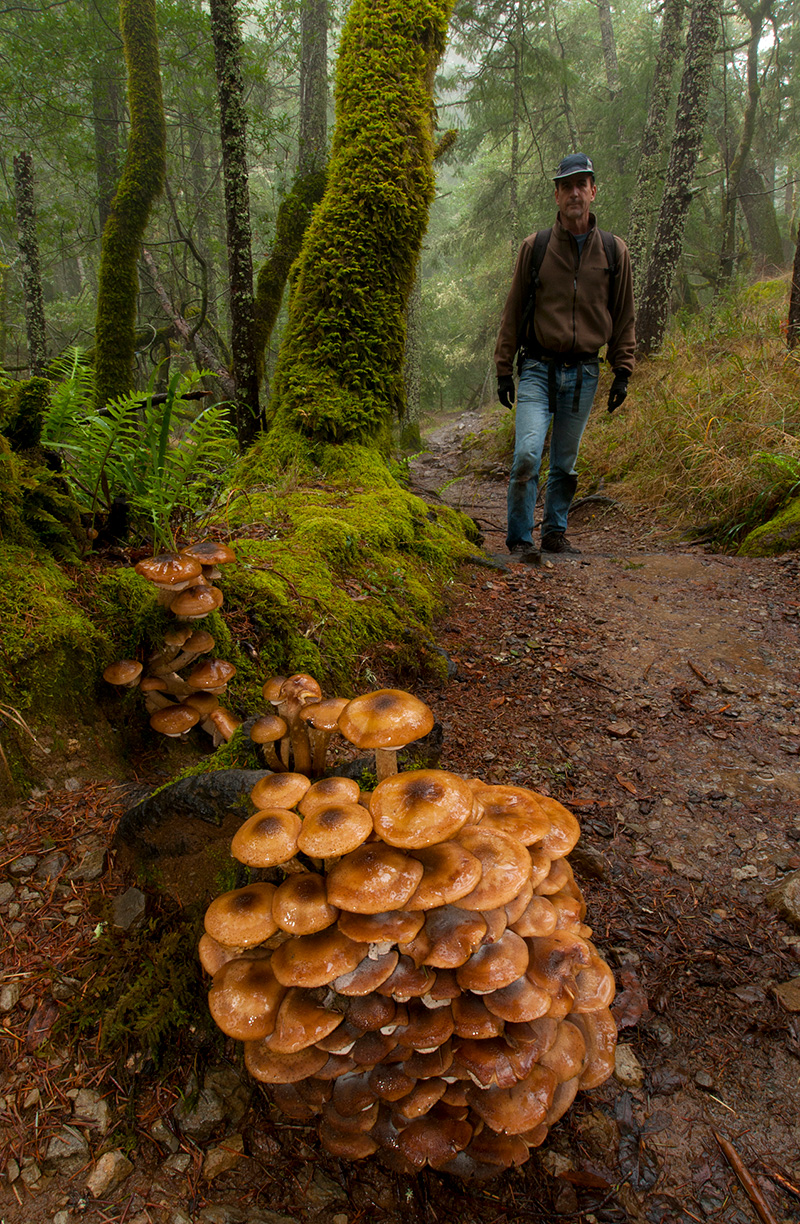
Adding to the challenge of mushroom identification, it’s likely that whatever mushroom reference guide you own is obsolete. Mycology, like every other branch of biology, has had its own genetic revolution. “We’ve had data from DNA sequencing for the last 15 years or so,” says R. Michael Davis of UC Davis, coauthor of the new UC Press Field Guide to Mushrooms of Western North America. “People have been putting different pieces of the puzzle together.” For instance, our local chanterelles have been recognized as a distinct species, Cantharellus californicus; so has the spring coccora (Amanita vernicoccora).
All that species variety is matched in the many ways fungi have to make a living. The button mushrooms you see at the grocery store are part of a group of fungi called saprobes, which extract nutrients from decaying organic material. You can think of them as the recycling crew, breaking down the cellulose in leaves and the lignin in wood; some colonize the droppings of ruminants and other herbivorous mammals. Beyond that, it all becomes much more complex.
By far the most important ecological relationships for fungi are their symbioses with vascular plants, in which fungal hyphae link up with plant roots to form mycorrhizal nodes. Through these junctions, fungi provide nutrients, water, and sometimes minerals to the plants, while plants provide sugars that feed the fungi. Such relationships can be incredibly specialized and many are crucial to the growth and survival of the trees and shrubs that define so many local habitats, from the oaks, buckeyes, and pines of Sunol Regional Wilderness to the chaparral, bay laurel, manzanita, and redwoods of the Oakland hills. “Fungi and plants have evolved together; the world as we know it would not exist without fungi,” says Viess.
One mycorrhizal group, which actually penetrates plants’ roots, dates to 600 million years ago, when plants first colonized land. Another group evolved 130 million years ago and includes 10,000 fungal species, many common mushrooms among them. These surround the plant root with fungal tissue.
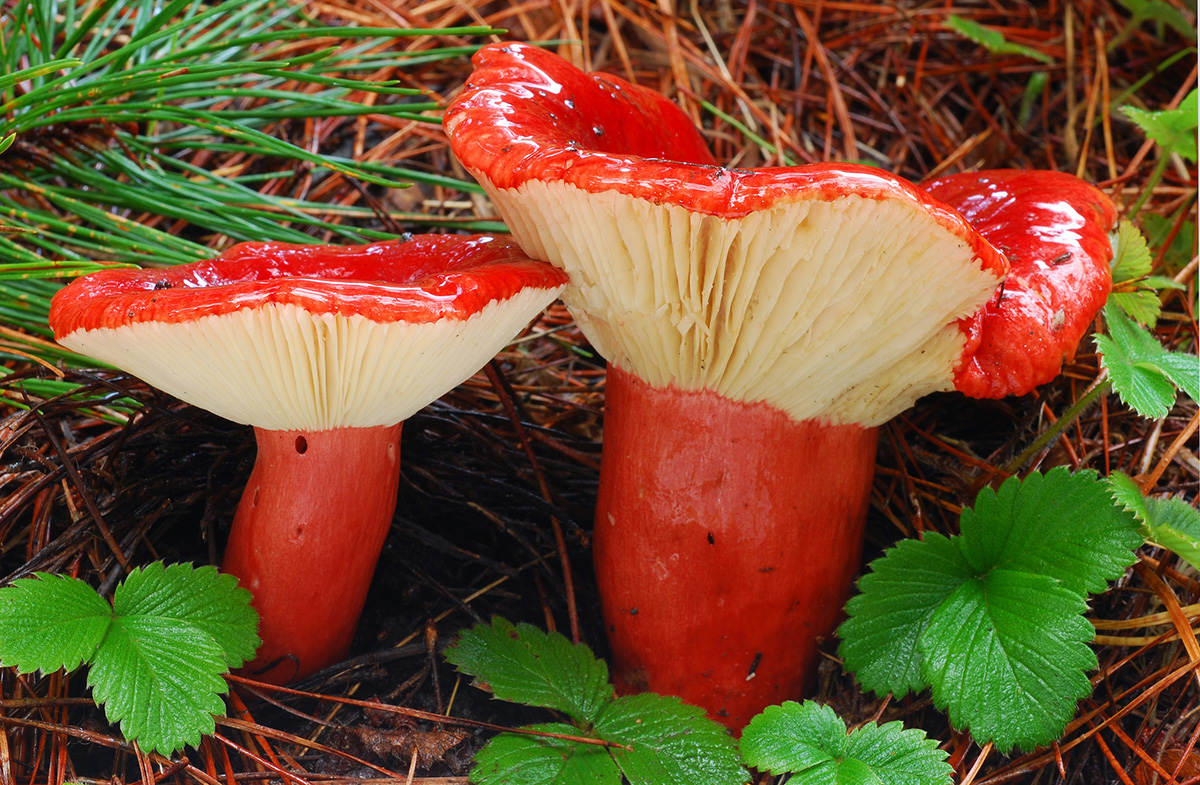
Some mycorrhizal fungi form partnerships specifically with manzanitas and madrones. Other species are found only with alders, or with Douglas fir. On the other hand, plants are less picky about their fungal partners. “A pine tree can have hundreds or thousands of [mycorrhizal] associates,” says Tom Bruns of UC Berkeley, whose lab focuses on these relationships. “Each host has many choices among the things that specialize on it.”
As Bruns explains it, mycorrhizal mushrooms have a sweet deal: “They’ve contracted out to find nutrients for these large woody hosts and are paid very well in sugars. They have the resources to make big mushrooms, the conspicuous boletes and russulas. Everything else has to fight for little pieces of decaying wood. It’s a huge tax on the host, but it increases the host’s productivity.” Many mycorrhizal fungi provide nitrogen, phosphorus, and potassium, while some specialists dissolve rocks by secreting citric and oxalic acids and give their partners calcium and magnesium. Others protect their hosts from root pathogens.
Predation seems an unlikely life strategy for a mushroom, but at least two local species have gone this route. In addition to breaking down organic material, the widespread oyster mushroom’s mycelia consume tiny nematode worms that wander by. The fungal hyphae secrete a toxin that stuns the worm, then colonize and digest it. Laccaria bicolor preys on the insect-like arthropods called springtails, passing nutrients from their bodies on to its mycorrhizal plant partners.
Stealing nutrients from a living host is another option. Two western species of the mushroom-forming genus Elaphocordyceps parasitize truffles. The related Cordyceps victimizes the immature stages of moths and butterflies or the nymphs of cicadas in our region. Spores infest a living larva; the fungus kills it when it begins to transform into a pupa. Club-shaped fruiting bodies grow out of the host’s corpse. Lobster mushrooms (Hypomyces) parasitize other mushrooms, forming a crust over the fruiting bodies of russulas and milk caps. Honey mushrooms and polypores are tree parasites.
“There is no ‘typical’ mushroom lifestyle,” says Viess. The much-prized morels are “the original opportunists.” Some form mycorrhizal associations; some don’t. The one safe generalization about morels is that mass fruitings follow forest fires in the mountains. “Morels occur anywhere they want: wood chips, flowerpots, between the mortar of bricks,” she adds. I believe her: I discovered a morel in the hardpan of my backyard in the Berkeley flatlands just after I moved in, 17 years ago. I haven’t seen one there since.
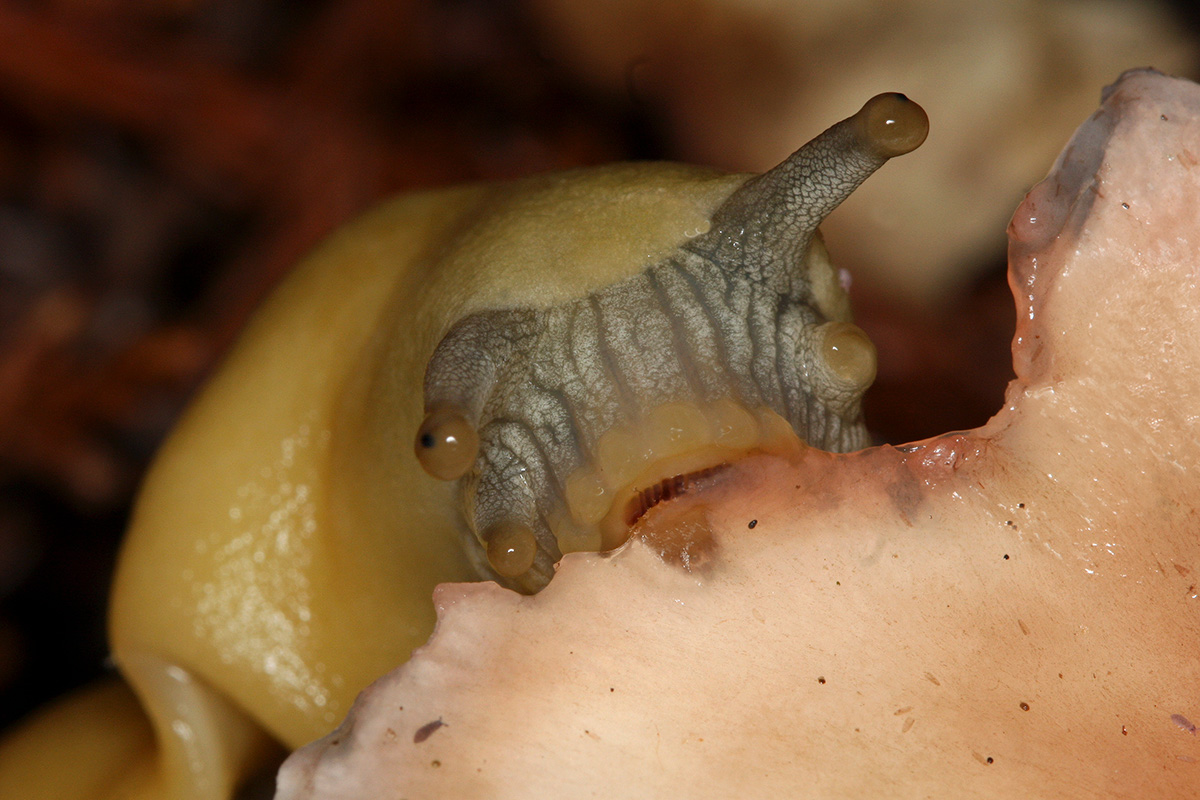
Mushrooms sustain a wide array of animals, some of which help out by dispersing spores. Snails and slugs are avid mushroom eaters. “There are a ton of insects that depend on woody shelf fungi and other mushrooms,” says Russo. Several beetle families are mycophagous, including the oddly named pleasing fungus beetles. Even the unappetizing Annulohypoxylon, whose fruiting bodies on dead oak wood resemble miniature charcoal briquettes, is food for a certain species of moth. Russo says almost all the gilled mushrooms and boletes harbor insects; the newly reclassified California chanterelle, however, is normally insect-free.
While some mushrooms attract insects and other invertebrates by smell, a few use light. According to biologist Dennis Desjardin of San Francisco State University, bioluminescence occurs in four different fungal lineages and appears to have been inherited from an ancient common ancestor. The cold fire of fungi is produced by the interaction of substances called luciferin and luciferase, chemically distinct from analogous compounds used by fireflies and deep-sea fish. Sometimes, as in the jack-o-lantern mushroom (Omphalotus olivascens), the fruiting body glows; in the honey mushrooms, the underground hyphae are the source of foxfire, a bluish-green glow sometimes seen in decaying wood.
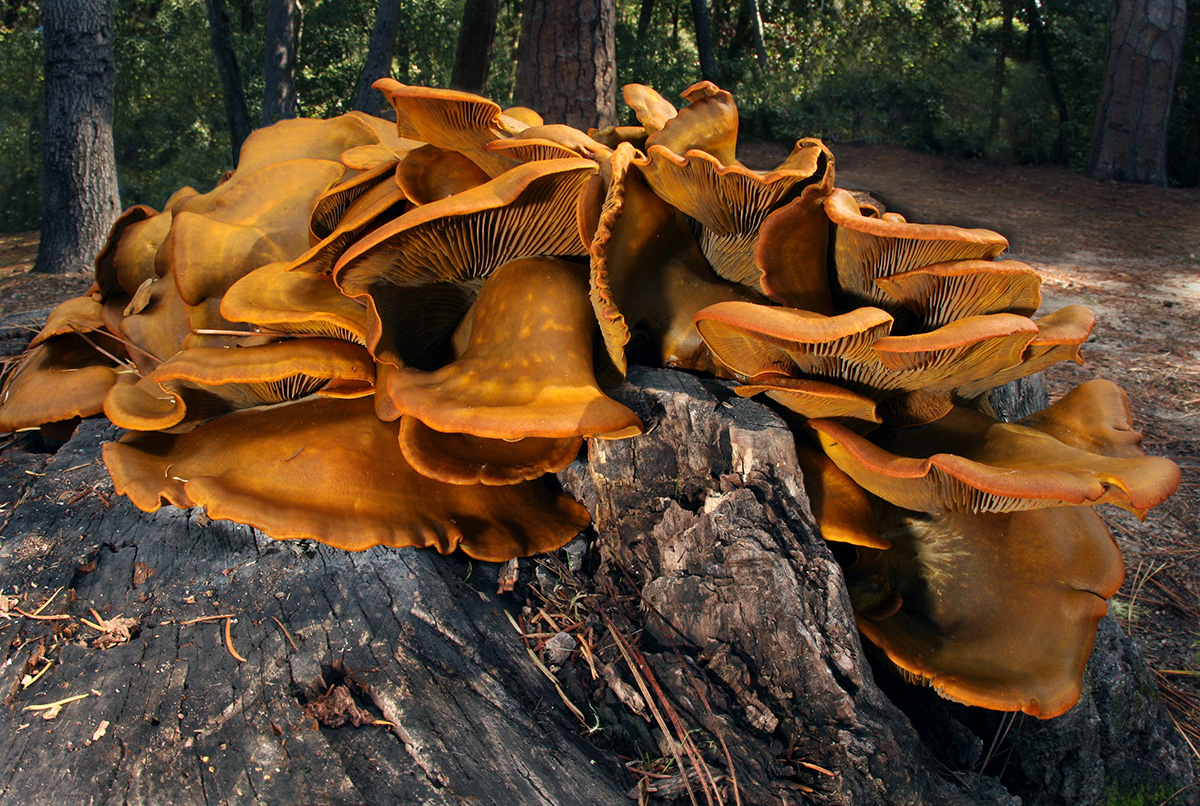
No one’s quite sure why so many mushrooms are toxic. “Mycologists lack a satisfactory theory for the meaning of mushroom toxins,” writes botanist Nicholas Money of Miami University in his recent book Mushroom. Toxins can deter predators, or they may be a metabolic byproduct. “It would be more effective for the mushroom to be distasteful than to be lethal,” notes author Arora. He suggests that amanitas, more dependent on airborne spore dispersal than animal transport, may benefit from a chemical deterrent. However, the genus Amanita contains both edible (to humans) and lethal species.
Toxins aside, larger creatures also feed on mushrooms, both the above-ground fruiting bodies and the subterranean truffles. No East Bay mammals are fungal specialists, but several species are opportunistic mushroom eaters. Small native rodents like deer mice and wood rats include fungi in their diets, as does the introduced fox squirrel. Their droppings package fungal spores, yeasts, nitrogen-fixing bacteria, and nutrients?–?a perfect recipe for the spores to thrive. Russo says fox squirrels store mushrooms in their nests as winter provisions. Black-tailed deer dig up truffles on occasion and relish Amanita muscaria. Feral pigs have a taste for truffles; Russo has seen oak savannas at Sunol and Ohlone Wilderness that the pigs have rototilled for fungi and bulbs. Viess says pigs prefer russulas and edible amanitas and avoid chanterelles. An East Coast mycologist has observed wild turkeys feeding on morels.
Mushroom eating (mycophagy) is a well-established, although not universal, human trait as well. We know that the Ohlone and Miwok people of the East Bay harvested and ate mushrooms, although specifics are hard to come by. The Sierra Miwok recognized at least eight kinds of edible mushrooms, including three puffballs and a shelf fungus that was also used as a poultice for wounds and a treatment for arthritis. They ate some species raw, some sun-dried, and others boiled. The Rumsen- and Mutsun-speaking Ohlone of the Santa Clara Valley roasted mushrooms on coals. Up the coast, the Kashaya Pomo baked chanterelles, boletes, and oyster mushrooms on hot stones, but regarded puffballs as poisonous.

All the species mentioned so far are native and local. Exotic mushrooms may not be on most conservationists’ radar, but they’re around. Mycorrhizal species can travel with their host plants. “If you move living plant material, you’re moving stuff with it,” says Bruns. Sometimes the introductions are low-impact: “Eucalyptus fungi came to California with the trees, but there’s pretty low diversity.”
The death cap (Amanita phalloides), which is thought to have arrived in the roots of cork oaks, may have had diverse European origins; the Bay Area population appears related to that in mainland France. Whatever its provenance, it took readily to the native coast live oak and later to tanoak. Death caps were collected at the Del Monte Hotel in Monterey in 1938 and on the UC Berkeley campus in 1945. “It was found as an isolated population in the Santa Cruz Mountains in the ’60s or ’70s, then popped up all over the place,” recalls Russo. “Near Joaquin Miller Park in Oakland there was a fairy ring of phalloides 25 or 30 feet across.” Bruns and other mycologists have calculated that this invasive symbiont is expanding its California range by about 10 kilometers [about six miles] per year. Is it competing with natives? “That’s just a theory,” David Arora says. “It could be just a niche they were grabbing that wasn’t occupied.”
California has no special-status mushroom species, but local declines in some Bay Area species have been observed. “There’s a whole suite of Agaricus species that used to be abundant in grazed coastal pastures,” says Arora. “They disappeared almost completely in the late ’90s. It’s an open question why.” The habitat hasn’t changed, and the mushrooms weren’t heavily gathered. He suspects a change in the soil microfauna, but that theory remains speculative.
Although mushrooms are protected from picking in the regional parks, nonconsumptive mushrooming is another matter: On winter days, you can always enjoy these extraordinary and highly photogenic organisms in situ. After all, birders seldom eat grilled warblers on toast.
Special thanks to Debbie Viess for assistance with this article.


